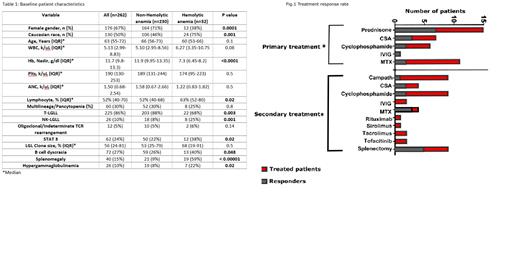Introduction
Large granular lymphocytic leukemia (LGLL) is characterized by a clonal proliferation of cytotoxic CD8+ T or CD3− natural killer (NK) cells. The disease typically presents with neutropenia in about 39-62% of patients, and anemia in up to 50% 1. While most cases of anemia in LGLL resemble pure red cell aplasia and present as reticulocytopenic and malproductive, we have also observed rare instances of hemolytic anemia (HA) with a high reticulocyte count. This unique and atypical presentation has prompted us to investigate the clinical features of LGLL with HA, aiming to gain insights into the pathogenesis of both conditions. In light of this, we conducted a comprehensive and systematic study of hemolysis within the context of LGLL.
Methods
We retrospectively examined clinical and molecular features of a large series of LGLL cases (n=262) diagnosed and managed at the Cleveland Clinic Foundation from 1998 to 2023 to identify those experiencing hemolysis. LGLL diagnosis was based on the presence of i) elevated LGL count (>0.5 × 10^9/L), ii) clonal TCR rearrangement, iii) VB expansion, iv) flow cytometric detection of aberrant CTL or NK cell proliferation and v) STAT3/5 mutation and vi) LGLL infiltration of the marrow. A diagnosis was established with >4/6 criteria fulfilled. HA diagnosis was based on evidence at any time during clinical course of laboratory signs of hemolysis.
Results
Overall, the median age at diagnosis was 63 years (IQR: 55-72) with a M:F ratio of 0.5. Majority of patients had been diagnosed with T-LGLL (n=225), whereas 22 had NK-LGLL. In 32/262 cases (12%), clinical and laboratory features were asserted to establish the diagnosis of HA. Of these, 22 (68%) had T-LGLL and 8 (25%) had NK-LGLL (Table 1). When comparing HA patients to the rest of the cohort, we observed a higher proportion of NK-LGLL cases with HA (25% vs 8%, p < 0.001). HA presented as the initial sign of the disease in majority of patients (88%), and 40% of them required transfusion support based on the degree of anemia and hemodynamics. The direct anti-globin test was positive in 30% of cases. Warm autoimmune HA (AIHA) was observed in 23% of patients, cold agglutinin disease in 7%, and one patient had both. Among 7 patients with IgG AIHA, 5 were also positive for anti-C3b, C3d antibodies. Two-thirds of the patients had multilineage cytopenia. Coexisting B-cell dyscrasia was identified in 13 cases, more frequently in HA than in those without (40% vs 26%, p=0.048), and autoimmune disorders in 8 cases (25%). HA in LGLL was also more likely to be associated with presence of splenomegaly (59% vs 21%, p<0.00001) and polyclonal hypergammaglobulinemia (22% vs 8%, p=0.02). Notably, STAT3 mutations were present in a higher proportion of HA patients (38% vs 22%, p=0.02), whereas median LGLL clone size (%) was similar between groups (68% vs 53%, p=0.5).
Overall, 77% of HA patients received treatment, and 16% had still evidence of hemolysis at a median follow-up of 82 months. The majority (47%) were treated with steroids with a positive, albeit transient response (7 out of 15 treated). Other first-line treatments and their corresponding median duration of response (months) included cyclosporine (n=7, 72 months), cyclophosphamide (n=5, 72 months), IVIG (n=1, 16 months), and methotrexate (n=11, 21 months). Subsequent lines of therapy included campath (n=9), cyclosporine (CSA) (n=4), cyclophosphamide (n=9), intravenous immunoglobulin (IVIG) (n=2), MTX (n=4), rituximab (n=1), sirolimus (n=1), tacrolimus (n=2), and tofacitinib (n=2). Splenectomy was performed as definitive treatment for refractory cytopenia in 9 patients, with a durable response in 5 patients at last follow-up ( Fig.1).
Conclusions
Based on this large series, our study illustrates that LGLL represents a clonal lymphoproliferative disorder that is closely linked to HA. Notably, NK-LGLL cases exhibited a stronger association with HA. Our observations indicate that treatment with steroids and other therapeutic agents resulted in positive responses in a fraction of patients, while splenectomy demonstrated the most enduring response. These significant findings contribute substantially to advancing our comprehension of LGLL-associated HA and its optimal management strategies. AIHA in patients with LGLL points towards a global immune dysfunction in this disease beyond clonal cytotoxic T/NK cell expansion.
Disclosures
Maciejewski:Novartis: Honoraria, Speakers Bureau; Omeros: Consultancy; Alexion: Membership on an entity's Board of Directors or advisory committees; Regeneron: Consultancy, Honoraria.


